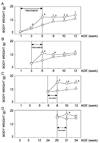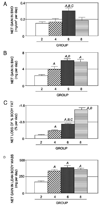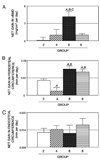Evidence that sensitivity to growth hormone (GH) is growth period and tissue type dependent: studies in GH-deficient lit/lit mice
- PMID: 12933669
- PMCID: PMC2923915
- DOI: 10.1210/en.2002-0123
Evidence that sensitivity to growth hormone (GH) is growth period and tissue type dependent: studies in GH-deficient lit/lit mice
Abstract
We previously found that the magnitude of skeletal deficits caused by GH deficiency varied during different growth periods. To test the hypothesis that the sensitivity to GH is growth period dependent, we treated GH-deficient lit/lit mice with GH (4 mg/kg body weight.d) or vehicle during the prepubertal and pubertal (d 7-34), pubertal (d 23-34), postpubertal (d 42-55), and adult (d 204-217) periods and evaluated GH effects on the musculoskeletal system by dual energy x-ray absorptiometry (DEXA) and peripheral quantitative computed tomography. GH treatment during different periods significantly increased total body bone mineral content, bone mineral density (BMD), bone area, and lean body mass and decreased percentage of fat compared with vehicle; however, the magnitude of change varied markedly depending on the treatment period. For example, the increase in total body BMD was significantly (P < 0.01) greater when GH was administered between d 42-55 (15%) compared with pubertal (8%) or adult (7.7%) periods, whereas the net loss in percentage of body fat was greatest (-56%) when GH was administered between d 204 and 216 and least (-27%) when GH was administered between d 7 and 35. To determine whether GH-induced anabolic effects on the musculoskeletal system are maintained after GH withdrawal, we performed DEXA measurements 3-7 wk after stopping GH treatment. The increases in total body bone mineral content, BMD, and lean body mass, but not the decrease in body fat, were sustained after GH withdrawal. Our findings demonstrate that the sensitivity to GH in target tissues is growth period and tissue type dependent and that continuous GH treatment is necessary to maintain body fat loss but not BMD gain during a 3-7 wk follow-up.
Figures





Similar articles
-
Insulin-like growth factor regulates peak bone mineral density in mice by both growth hormone-dependent and -independent mechanisms.Endocrinology. 2003 Mar;144(3):929-36. doi: 10.1210/en.2002-220948. Endocrinology. 2003. PMID: 12586770 Free PMC article.
-
Liver-derived IGF-I contributes to GH-dependent increases in lean mass and bone mineral density in mice with comparable levels of circulating GH.Mol Endocrinol. 2011 Jul;25(7):1223-30. doi: 10.1210/me.2011-0047. Epub 2011 Apr 28. Mol Endocrinol. 2011. PMID: 21527499 Free PMC article.
-
Growth hormone (GH)-independent stimulation of adiposity by GH secretagogues.Biochem Biophys Res Commun. 2001 Jan 12;280(1):132-8. doi: 10.1006/bbrc.2000.4065. Biochem Biophys Res Commun. 2001. PMID: 11162489
-
Growth velocity, final height and bone mineral metabolism of short children treated long term with growth hormone.Curr Pharm Biotechnol. 2000 Jul;1(1):33-46. doi: 10.2174/1389201003378997. Curr Pharm Biotechnol. 2000. PMID: 11467359 Review.
-
Impact of growth hormone status on body composition and the skeleton.Horm Res. 2004;62 Suppl 3:35-41. doi: 10.1159/000080497. Horm Res. 2004. PMID: 15539797 Review.
Cited by
-
Growth Hormone Effects on Bone Loss-Induced by Mild Traumatic Brain Injury and/or Hind Limb Unloading.Sci Rep. 2019 Dec 12;9(1):18995. doi: 10.1038/s41598-019-55258-9. Sci Rep. 2019. PMID: 31831786 Free PMC article.
-
Whole genome microarray analysis of growth hormone-induced gene expression in bone: T-box3, a novel transcription factor, regulates osteoblast proliferation.Am J Physiol Endocrinol Metab. 2006 Jul;291(1):E128-36. doi: 10.1152/ajpendo.00592.2005. Epub 2006 Feb 7. Am J Physiol Endocrinol Metab. 2006. PMID: 16464905 Free PMC article.
-
Mechanisms of gender-specific regulation of mouse sulfotransferases (Sults).Xenobiotica. 2011 Mar;41(3):187-97. doi: 10.3109/00498254.2010.535923. Epub 2010 Nov 23. Xenobiotica. 2011. PMID: 21091322 Free PMC article.
-
Effects of growth hormone on the ontogenetic allometry of craniofacial bones.Evol Dev. 2013 Mar-Apr;15(2):133-45. doi: 10.1111/ede.12025. Evol Dev. 2013. PMID: 25098638 Free PMC article.
-
Regulation of skeletal growth and mineral acquisition by the GH/IGF-1 axis: Lessons from mouse models.Growth Horm IGF Res. 2016 Jun;28:26-42. doi: 10.1016/j.ghir.2015.09.004. Epub 2015 Sep 28. Growth Horm IGF Res. 2016. PMID: 26432542 Free PMC article. Review.
References
-
- Baylink DJ, Strong D, Mohan S. The diagnosis and treatment of osteoporosis: future prospects. Mol Med Today. 1999;5:133–140. - PubMed
-
- Saggese G, Federico G, Cinquanta L. Plasma growth hormone-binding protein activity, insulin-like growth factor I, and its binding protein levels in patients with Turner’s syndrome: effect of short- and long-term recombinant human growth hormone administration. Pediatr Res. 1995;37:106–111. - PubMed
-
- Eisman JA. Genetics of osteoporosis. Endocr Rev. 1999;20:788–804. - PubMed
-
- Richman C, Kutilek S, Miyakoshi N, Srivastava AK, Beamer WG, Donahue LR, Rosen CJ, Wergedal JE, Baylink DJ, Mohan S. Postnatal and pubertal skeletal changes contribute predominantly to the differences in peak bone density between C3H/HeJ and C57BL/6J mice. J Bone Miner Res. 2001;16:386–397. - PubMed
-
- Matkovic V. Editorial: skeletal development and bone turnover revisited. J Clin Endocrinol Metab. 1996;81:2013–2016. - PubMed
Publication types
MeSH terms
Substances
Grants and funding
LinkOut - more resources
Full Text Sources
Other Literature Sources
Molecular Biology Databases

